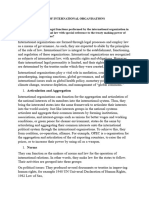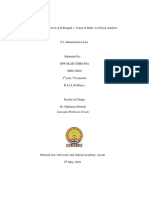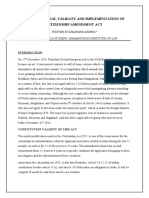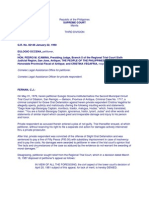Law and Poverty
Law and Poverty
Uploaded by
KotharihemantCopyright:
Available Formats
Law and Poverty
Law and Poverty
Uploaded by
KotharihemantOriginal Description:
Copyright
Available Formats
Share this document
Did you find this document useful?
Is this content inappropriate?
Copyright:
Available Formats
Law and Poverty
Law and Poverty
Uploaded by
KotharihemantCopyright:
Available Formats
LAW AND POVERTY
Syllabus 4th Semester NLU, Delhi
CONCEPTIONS OF POVERTY AND ITS MEASUREMENT
(i) (ii) (iii) Absolute Poverty Relative Poverty Capabilities Approach to Poverty
Notion of impoverishment will be used to critique the dominant conceptions of poverty. (v) (vi) Readings: 1. Michael Haralambos (1980) SOCIOLOGY: THEMES AND PERSPECTIVES, Oxford University Press, New York Chapter 4. 2. Amartya Sen (1981) POVERTY AND FAMINES, Oxford University Press, New York - chapter 2, 3. 3. Amartya Sen (2000) DEVELOPMENT AS FREEDOM, Oxford University Press, New Delhi Chapter 4 4. Arjan de Haan (2008) Social Exclusion: Towards a Holistic Understanding of Deprivation, in Arjan de Haan and Naila Kabeer SOCIAL EXCLUSION: TWO ESSAYS, Critical Quest, New Delhi, pp. 1-18. 5. Report of the Expert Group to Review the Methodology for Estimation of Poverty, Planning Commission, Govt. of India, Nov. 2009, available at planningcommission.nic.in. 6. Madhura Swaminathan, A Methodology Deeply Flawed, The Hindu, 5 th Feb 2010, p. 8. 7. Upendra Baxi (ed.) (1988) LAW AND POVERTY: CRITICAL ESSAYS, N.M.Tripathi, New Delhi - Introduction Measurement of poverty in India The Method Constitutionality of Poverty Line
8. Human Development Report 1997, United Nations Development Programme.
II
RELATIONSHIP BETWEEN LAW AND POVERTY
(i) (ii) Theoretical Considerations Relationship between Law, Poverty and Violence: Revisiting Naxalism
In this unit, the discussion would focus on understanding the relationship between law and poverty as it is envisaged within the sociological and Marxian approaches towards law. The aim would be to assess the ameliorative potential of law with respect to the poor. Readings: 1. Upendra Baxi (1993) MARX, LAW AND JUSTICE, M.N.Tripathi, New Delhi, Chapters 2 and 3 2. Upendra Baxi (1982) THE CRISIS OF INDIAN LEGAL SYSTEM, Vikas Publishing House, New Delhi chapter 1 and 2.
III
Law, Justice and the Poor
(i) Constitution: Promises to the Poor Civil, Political and Economic, Social and Cultural Rights Issue of justiciability
This section explores the constitutional promises with respect to socially and economically marginalized. The nature and scope of the promises and their ameliorative potential. Readings: 1. S.Murlidhar (2004) Economic, Social and Cultural Rights: An Indian Response to the Justiciability Debate, in Yash Ghai and Jill Cotrell (eds.) ECONOMIC, SOCIAL AND CULTURAL RIGHTS IN PRACTICE: THE ROLE OF JUDGES IN IMPLEMENTING ECONOMIC, SOCIAL AND CULTURAL RIGHTS, INTERIGHTS, London. 2. M. P. Singh, The Statics and the Dynamics of the Fundamental Rights and the Directive Principles A Human Rights Perspective, (2003)5 SCC (J) 1.
3. Onara O Neill (1986) FACES OF HUNGER: AN ESSAY ON POVERTY, JUSTICE AND DEVELOPMENT, Allen and Unwin, London Chapter 6, pp. 97-120.
(ii)
Poverty and the Criminal Justice System a) Poverty and Criminality: Some Issues b) Criminal Procedure In this section we will explore the basis for the identification of an act as a crime especially with reference to crimes like suicide, beggary as well as the notion of autonomy and free will that an individual is attributed with, in the context of his criminal acts. We would also focus on the interface between poor accused/victim, criminal justice process and its consequences in terms of impoverishment.
Readings: 1. Meena Radhakrishna (2008) Laws of Metamorphosis: From Nomad to Offender, in Kalpana Kannabiran and Ranbir Singh (eds.) CHALLENGING RULE(S) OF LAW: COLONIALISM, CRIMINOLOGY AND HUMAN RIGHTS IN INDIA, Sage, New Delhi, pp. 3-27. 2. S. Murlidhar (2004) LAW, POVERTY AND LEGAL AID: ACCESS TO CRIMINAL JUSTICE, Lexis Nexis Butterworths, New Delhi Chapter 6, pp. 255 284. 3. B. B. Pande (1988) Vagrants, Beggars and Status Offenders, in Upendra Baxi (ed.) LAW AND POVERTY: CRITICAL ESSAYS, N.M.Tripathi, New Delhi, pp. 248-276. 4. K.D.Gaur (1988) Poor as Victims of Uses and Abuses of Criminal Law and Process, in LAW AND POVERTY: CRITICAL ESSAYS, N.M.Tripathi, New Delhi, pp. 63-97. 5. 156th report of The Law Commission of India on The Indian Penal Code, portion on suicide. 6. P. Sainath (2007) The Agrarian Crisis, in Michael Higgins et al (eds.) FOOD SECURITY AND JUDICIAL ACTIVISM IN INDIA, Human Rights law Network, pp. 89-97.
(iii)
Labour Law and the Poor Minimum Wages Act, 1948
Bonded Labour (Abolition) Act, 1976 Child Labour (Prohibition and Regulation) Act, 1986 The Unorganised Workers Social Security Act, 2008
The arena of labour law will be explored to assess the nature and kind of norms embodied to prevent impoverishment and the implementation of those norms will also be evaluated. Readings: 1. T. S. Sankaran, The Unorganised Workers' Social Security Act, 2008 - A Critique, available at http://www.lawyerscollective.org/magazine/dec2008-jan2009/feature5
2. Report on Conditions of Work and Promotion of Livelihood in the Unorganised Sector (2007) National Commissions for Enterprises in the Unorganised Sector, available at http://nceus.gov.in/Condition_of_workers_sep_2007.pdf 3. Peoples Union for Democratic Rights v. Union of India AIR 1982 SC 1423. 4. Bandhua Mukti Morcha v. Union of India AIR 1984 SC 802.
(iv)
Law, Social Justice and the Poor Protection of Civil Rights Act, 1955 Scheduled Caste and Schedule Tribes (Prevention of Atrocities) Act, 1989 Employment of Manual Scavengers and Construction of Dry Latrines (Prohibition) Act, 1993
Social exclusion, being integral to and a significant aspect of poverty, this section will dwell upon the role of law as an instrument of social change and its potential in the context marked by systematic and deep-rooted social segregation. Readings: 1. S. R. Sankaran (2008) Social Exclusion and Criminal Law, in in Kalpana Kannabiran and Ranbir Singh (eds.) CHALLENGING RULE(S) OF LAW:
COLONIALISM, CRIMINOLOGY AND HUMAN RIGHTS IN INDIA, Sage, New Delhi, pp. 121-141. 2. Bhim Rao Ambedkar, Annihilation of Caste, in WRITINGS AND SPEECHES OF DR. BHIM RAO AMBEDKAR, vol - I, Govt. of India. 3. Upendra Baxi (1988) Untouchability: Constitution, Law and Plan, in Upendra Baxi (ed.) LAW AND POVERTY: CRITICAL ESSAYS, N.M.Tripathi, New Delhi, pp. 165-174. 4. Upendra Baxi (1988) The Protection of Civil Rights Act: Pitfalls in Implementation, in Upendra Baxi (ed.) LAW AND POVERTY: CRITICAL ESSAYS, N.M.Tripathi, New Delhi, pp. 175-185. 5. Combat Law Special Issue on Scheduled Castes and Scheduled Tribes (Prevention of Atrocities) Act, 1989, Sept-Dec 2009. 6. Report on Prevention of Atrocities against Scheduled Castes (2006) National Human Rights Commission
STRATEGIES FOR POVERTY ALLEVIATION AND THE CHALLENGES
IV (i) Welfare This will include discussion on a few programmes and schemes of the govt. (ii) Rights Role of Legislature o Mahatma Gandhi National Rural Employment Guarantee Act, 2005 The Right of Children to Free and Compulsory Education Act, 2009
Role of Bench and Bar This sub-section focuses on the engagement of the judiciary and lawyers with the legal issues pertaining to the conditions of poor. The role of the two in recognition and realization of rights of the poor in the light of Constitutional guarantees along with the efficacy of litigation as a strategy and strategy of litigation in the furtherance of rights of the poor will be examined.
(a) Role of Civil Society Struggle for State Accountability o o (iii) Right to Information Social Audit
Narmada Bachao Aandolan Right to food Movement
Self help Case studies
The primary focus of the unit will be the rights approach to poverty alleviation, while making an effort to distinguish it from welfare emphasizing the prospects and challenges in the context of the two. A basic understanding of the significance of economic, social rights discourse with respect to the conditions of the poor will be developed and standards used to assess the violation of these rights will also be delved into. Rights are used as a strategy for addressing different facets of poverty both by the state (through the recognition and creation of conditions for enjoyment and enforcement of rights) and by the civil society (by claiming recognition, enjoyment and exercise of rights). The section will undertake an evaluation of these endeavours. The third strategy which is separately recognized for discussion is self help or local initiative which may or may not adopt an approach geared towards formal recognition of a right by the state but involves strategies aiming at amelioration of conditions of the poor by individual or collective efforts. Readings: 1. Henry Shue (1996) BASIC RIGHTS: SUBSISTENCE, AFFLUENCE AND U.S. FOREIGN POLICY, Princeton University Press, New Jersey 2. Usha Ramanathan (2008) Eminent Domain, Protest and the Discourse on Rehabilitation, in Michael Cernea, Hari Mohan Mathur (eds.) CAN COMPENSATION PREVENT IMPOVERISHMENT, Oxford University Press, New Delhi, pp. 209-229. 3. Bernard D Mello Environmental Impact of Large Dams: A Social Critique, http://www.3inetwork.org/reports/IIR2002/HTML/chapter5.HTML
4. Jean Dreze (2007) Employment Guarantee Act and the Right to Food, in Michael Higgins et al (eds.) FOOD SECURITY AND JUDICIAL ACTIVISM IN INDIA, Human Rights law Network, pp.81-85. 5. B. B. Pande The Constitutionality of Basic Human Needs: An Ignored Area of legal Discourse, (1989) 4 SCC (J) 1. 6. Upendra Baxi (1982) THE CRISIS OF INDIAN LEGAL SYSTEM, Vikas Publishing House, New Delhi chapter 1 and 2. 7. Fernando Rojas A Comparison of change Oriented Legal Services in Latin America with Legal Services in North America and Europe, International Journal of the Sociology of Law, 1988 vol. 16, pp. 203-256. 8. Lucie E. White Mobilisation on the Margins of the Lawsuit: Making Space for Clients to Speak, 16 N.Y.U. Rev. L. and Soc. Change 535. 9. Harsh Mander (2003) Corruption and the Right to Information, in Rajesh Tandon and Ranjita Mohanti (eds.) DOES CIVIL SOCIETY MATTER? GOVERNANCE IN CONTEMPORARY INDIA, Sage Publications, New Delhi, pp. 145-163. 10.Bishnu M. Mohapatra (2003) A View from the Subalterns: The Pavement Dwellers of Mumbai, in Rajesh Tandon and Ranjita Mohanti (eds.) DOES CIVIL SOCIETY MATTER? GOVERNANCE IN CONTEMPORARY INDIA, Sage Publications, New Delhi, pp. 285-314. 11.Aruna Roy and Nikhil Dey NREGA: Breaking New Ground, http://www.hinduonnet.com/mag/2009/06/21/stories/2009062150010100.htm 12.Upendra Baxi (1988) Taking Suffering Seriously: Social Action Litigation in the Supreme court of India, in Upendra Baxi (ed.) LAW AND POVERTY: CRITICAL ESSAYS, N.M.Tripathi, New Delhi, pp. 387-415. 13.P. Sainath (2002) EVERYBODY LOVES A GOOD DROUGHT: STORIES FROM INDIAS POOREST DISTRICTS, Penguin Books, India. 14.P.Sainath Neo Liberal Terrorism in India: The Largest Wave of Suicides in History, http://www.counterpunch.org/sainath02122009.html 15.P.Sainath Farm Suicides: A Twelve Year Saga, http://beta.thehindu.com/opinion/columns/sainath/article94324.ece 16.Rajasthan PUCL Writ in Supreme Court on Famine Deaths, http://www.pucl.org/reports/Rajasthan/2001/starvation-writ.htm 17.The Special Economic Zones Act, 2005 18.The Land Acquisition Act, 1894.
19.The Scheduled Tribes and Other Traditional Forest Dwellers (Recognition of Forest Rights) Act, 2006 20.Olga Tellis v. Bombay Municipal Corporation (1985) 3 SCC 545. 21.Sodan Singh v. NDMC (1989) 4 SCC 155. 22.Azad Rickshaw Pullers Union v. State 1980 Supp SCC 601. 23.Narmada Bachao Aandolan v. Union of India AIR 2000 SC 3751. 24.Balco Employees v. Union of India (2002) 2 SCC 333. 25.Kali Das v. Govt. of Jammu and Kashmir (1987)3 SCC 430. 26.Unni Krishnan v. State of Andhra Pradesh (1993) 1 SCC 645.
You might also like
- Essential Soft Skills for Lawyers: What They Are and How to Develop ThemFrom EverandEssential Soft Skills for Lawyers: What They Are and How to Develop ThemNo ratings yet
- CaseComment On Shankari Prasad V Union of IndiaDocument4 pagesCaseComment On Shankari Prasad V Union of Indiasonia ShriNo ratings yet
- Jurisprudence ProjectDocument20 pagesJurisprudence Projectjay1singheeNo ratings yet
- I INTERNAL ASSIGNMENT-cpcDocument11 pagesI INTERNAL ASSIGNMENT-cpcRiya GuptaNo ratings yet
- Smith Fawcett ReDocument6 pagesSmith Fawcett ReMitheleshDevarajNo ratings yet
- Justice in Globalised WorldDocument4 pagesJustice in Globalised WorldJuan CervantesNo ratings yet
- Tribunalisation of Justice: Application of Droit Administratif in IndiaDocument9 pagesTribunalisation of Justice: Application of Droit Administratif in IndiaAkash AgarwalNo ratings yet
- Case Analysis AssignmentDocument13 pagesCase Analysis AssignmentTrinity NagpalNo ratings yet
- In Re Delhi Laws Act CaseDocument11 pagesIn Re Delhi Laws Act CaseArpitha Anna Mathew0% (1)
- Navtej Singh Johar Vs Union of IndiaDocument13 pagesNavtej Singh Johar Vs Union of IndiaAyush YadavNo ratings yet
- Murli DeoraDocument6 pagesMurli Deorakartiktyagi97No ratings yet
- Statute of Monopolies 1623Document28 pagesStatute of Monopolies 1623Srivardhan ShuklaNo ratings yet
- John Rawls Theory of Justice in Indian ScenarioDocument6 pagesJohn Rawls Theory of Justice in Indian ScenarioAnshulNo ratings yet
- What May Be Transferred (S.6) Property of Any KindDocument15 pagesWhat May Be Transferred (S.6) Property of Any KindsamNo ratings yet
- Symbiosis Law School, Pune: Rule of Law in Administrative LawDocument9 pagesSymbiosis Law School, Pune: Rule of Law in Administrative LawAarav TripathiNo ratings yet
- Kelson - Pure Theory of LawDocument16 pagesKelson - Pure Theory of LawHarneet KaurNo ratings yet
- Case Review-Muniswamy V Venkataswamy BA0150030.Document2 pagesCase Review-Muniswamy V Venkataswamy BA0150030.Prakhar Bhatt100% (2)
- Padma Sundara Rao v. State of T.N - 22-26Document5 pagesPadma Sundara Rao v. State of T.N - 22-26knkmurali100% (1)
- Anand Chintamani v. State of MaharashtraDocument16 pagesAnand Chintamani v. State of MaharashtraMrinalBhatnagarNo ratings yet
- Maneka Gandhi Vs Union of IndiaDocument9 pagesManeka Gandhi Vs Union of IndiaAditya SrivastavaNo ratings yet
- Administrative Law Is A Heuristic Science or An Organized Knowledge Based On Experiment Which Is Flexible and ChangingDocument129 pagesAdministrative Law Is A Heuristic Science or An Organized Knowledge Based On Experiment Which Is Flexible and ChanginganshulNo ratings yet
- Meaning and Purpose of Interpretation of StatuesDocument4 pagesMeaning and Purpose of Interpretation of StatuesSuman ChandaNo ratings yet
- Jurisprudence of Consumer and Competition LawDocument30 pagesJurisprudence of Consumer and Competition LawAditya Yash VyasNo ratings yet
- Clinical Assignment (Nikhat)Document59 pagesClinical Assignment (Nikhat)Nikhat zabiNo ratings yet
- Beneficial ConstructionDocument3 pagesBeneficial Constructionneeraj50% (2)
- Lakshmi Kant Pandey VS UoiDocument6 pagesLakshmi Kant Pandey VS UoiPriyanshu RanjanNo ratings yet
- Project - Socio Economic OffencesDocument10 pagesProject - Socio Economic Offencessrikant sirkaNo ratings yet
- Contracts IIDocument34 pagesContracts IINitya RNo ratings yet
- State of Gujarat & Anr Vs Acharya D. Pandey & Ors (1971 AIR 866)Document11 pagesState of Gujarat & Anr Vs Acharya D. Pandey & Ors (1971 AIR 866)Rvi MahayNo ratings yet
- Law of International OrganisationsDocument22 pagesLaw of International OrganisationsAmulya KaushikNo ratings yet
- Synopsis - Basics of Legislation PDFDocument5 pagesSynopsis - Basics of Legislation PDFKumar HarshitNo ratings yet
- Law and Social TransformationDocument23 pagesLaw and Social TransformationDilip JaniNo ratings yet
- Moot MemorialDocument12 pagesMoot MemorialvishnuameyaNo ratings yet
- Adm Jabalpur CaseDocument17 pagesAdm Jabalpur CaseRaja SoodNo ratings yet
- IPC Case Empror Vs Barendra KumarGhoseDocument5 pagesIPC Case Empror Vs Barendra KumarGhoseYash Raj100% (3)
- ADRDocument9 pagesADRAvtar singhNo ratings yet
- Standard Chartered Bank v. Heavy Engineering Corporation Ltd. (2020) 4 MLJ 104Document3 pagesStandard Chartered Bank v. Heavy Engineering Corporation Ltd. (2020) 4 MLJ 104Ipkshita SinghNo ratings yet
- Case Analysis On Independent Thought Vs UoiDocument13 pagesCase Analysis On Independent Thought Vs Uoidaisy jain100% (1)
- CRPC Project (190101131)Document21 pagesCRPC Project (190101131)Sonal YadavNo ratings yet
- Labor Law Case CommentDocument5 pagesLabor Law Case CommentAnklesh08No ratings yet
- EvidenceDocument15 pagesEvidenceAJIT SHARMANo ratings yet
- Joseph Shine Vs Union of IndiaDocument4 pagesJoseph Shine Vs Union of IndiaArjun PaigwarNo ratings yet
- Navtej Singh Johar Case Comment PDFDocument6 pagesNavtej Singh Johar Case Comment PDFArisha NusratNo ratings yet
- Advertising by Advocates: Submitted By: Ishan Arora Amity Law School Noida Uttar PradeshDocument27 pagesAdvertising by Advocates: Submitted By: Ishan Arora Amity Law School Noida Uttar Pradeshiarora88No ratings yet
- The Indian Contract Act, 1872Document10 pagesThe Indian Contract Act, 1872Balachandar KaliappanNo ratings yet
- A.K.Kraipak v. Union of IndiaDocument15 pagesA.K.Kraipak v. Union of Indiadiwakar chiraniaNo ratings yet
- Doctrine of Ejusdem Generis - IV SemesterDocument13 pagesDoctrine of Ejusdem Generis - IV SemesterTanuNo ratings yet
- Essay On CaaDocument4 pagesEssay On CaaShashank mishraNo ratings yet
- Role of Forensic Science in Criminal Justice SystemDocument154 pagesRole of Forensic Science in Criminal Justice SystemAumSharmaNo ratings yet
- Moti Singh V State of UPDocument5 pagesMoti Singh V State of UPDeeptimaan Yadav100% (1)
- Right To PrivacyDocument6 pagesRight To PrivacyAbhishek KumarNo ratings yet
- Gajanan Moreshwar v. Moreshwar MadanDocument4 pagesGajanan Moreshwar v. Moreshwar MadanYagnesh Patel100% (1)
- Solitary Confinement Is The Practice of Isolating People in Closed Cells For 22Document19 pagesSolitary Confinement Is The Practice of Isolating People in Closed Cells For 22abhishek100% (1)
- Family LawDocument11 pagesFamily LawVivaswan Shipra DeekshitNo ratings yet
- Pure Theory of Law Hans Kelson-Ltp..Document45 pagesPure Theory of Law Hans Kelson-Ltp..ShabnamNo ratings yet
- Module 8Document15 pagesModule 8Shaman KingNo ratings yet
- The Right Against Self-Incrimination and State of Bombay V. Kathi Kalu Oghad: A CritiqueDocument24 pagesThe Right Against Self-Incrimination and State of Bombay V. Kathi Kalu Oghad: A CritiqueAkshay SarjanNo ratings yet
- Relationship Between Law and Public OpinionDocument3 pagesRelationship Between Law and Public OpinionHimanshu BhatiaNo ratings yet
- Article 21 of The Indian ConstitutionDocument17 pagesArticle 21 of The Indian ConstitutionSaharsshNo ratings yet
- Situations Covered by The Law On NepotismDocument3 pagesSituations Covered by The Law On NepotismArlene Q. Samante100% (3)
- PD 1534Document2 pagesPD 1534Marj MendezNo ratings yet
- Business Situation As They Are Affected by The Filipino Value System and Recommended Ways of Confronting Ethical Challenges in The Business SettingDocument28 pagesBusiness Situation As They Are Affected by The Filipino Value System and Recommended Ways of Confronting Ethical Challenges in The Business SettingAngelita Dela cruzNo ratings yet
- Lozano vs. Depakakibo FulltextDocument3 pagesLozano vs. Depakakibo FulltextFrances Ann TevesNo ratings yet
- Tula Ram Vs Kishore Singh-AIR 1977 SC 2401Document5 pagesTula Ram Vs Kishore Singh-AIR 1977 SC 2401Manas Ranjan Samantaray100% (1)
- Application For Probation-JanrussDocument3 pagesApplication For Probation-Janrusstimothy miraflorNo ratings yet
- Lester Desjarlais Inquest Report Part IIIDocument187 pagesLester Desjarlais Inquest Report Part IIIJames TurnerNo ratings yet
- (CERDENA) SALFIE ALCAN v. IMPERIAL VEGETABLE OIL CO., Inc. G.R. No. 126751 March 28, 2001 PDFDocument1 page(CERDENA) SALFIE ALCAN v. IMPERIAL VEGETABLE OIL CO., Inc. G.R. No. 126751 March 28, 2001 PDFChaze CerdenaNo ratings yet
- Central University of South Bihar: Project-TopicDocument16 pagesCentral University of South Bihar: Project-Topicravishek kumarNo ratings yet
- Real OrdinanceDocument29 pagesReal OrdinanceRajeev SharmaNo ratings yet
- Republic of The PhilippinesDocument12 pagesRepublic of The PhilippinesDienizs Labini TadenaNo ratings yet
- Filinvest Credit Corp V CADocument2 pagesFilinvest Credit Corp V CATrisha OrtegaNo ratings yet
- Registration Form For BusinessDocument2 pagesRegistration Form For BusinessGilbert CookNo ratings yet
- Unfair Labor PracticeDocument4 pagesUnfair Labor PracticeInna De LeonNo ratings yet
- NLRC Case FlowDocument5 pagesNLRC Case Flowgliff edward100% (1)
- G.R. No. L-28554 - Unno Vs GMCDocument3 pagesG.R. No. L-28554 - Unno Vs GMCArmand Patiño AlforqueNo ratings yet
- Labor Law Article - Karen JimenoDocument57 pagesLabor Law Article - Karen JimenoBianca Viel Tombo Caligagan100% (2)
- Genava Conventions of 1949Document3 pagesGenava Conventions of 1949Marc VeldtNo ratings yet
- 3 Civil Law Justice Del Castillo DigestsDocument93 pages3 Civil Law Justice Del Castillo DigestsFatimah Mandangan67% (3)
- Bsi Fy16 Annual Report FinalDocument18 pagesBsi Fy16 Annual Report FinalShira SchoenbergNo ratings yet
- Occena Vs IcaminaDocument4 pagesOccena Vs IcaminaRachelle DomingoNo ratings yet
- Previous Year Questions On Jurisprudence - My Legal FriendDocument15 pagesPrevious Year Questions On Jurisprudence - My Legal FriendTuraga PraneethaNo ratings yet
- Non Disclosure Agreement TemplateDocument4 pagesNon Disclosure Agreement TemplateVijaya KrishnaNo ratings yet
- Questionnare For Comprehensive ExamDocument5 pagesQuestionnare For Comprehensive ExamStace Diane Deane StefanNo ratings yet
- PDF Guide To DivorceDocument8 pagesPDF Guide To DivorceIba LaçiNo ratings yet
- Revised and Localized CPP Sy 2023 2024Document38 pagesRevised and Localized CPP Sy 2023 2024Kenneth Panes Dela VegaNo ratings yet
- H.L.A. Hart - A Quick Summary.Document3 pagesH.L.A. Hart - A Quick Summary.cuddlebugsm100% (2)
- Employment History: Name Address OccupationDocument4 pagesEmployment History: Name Address OccupationNasir AhmedNo ratings yet
- Vokes v. Arthur Murray, 1968Document3 pagesVokes v. Arthur Murray, 1968thisisatrolNo ratings yet
- Cycleof ViolencestagesDocument3 pagesCycleof ViolencestagesAnuradha ItwaruNo ratings yet

























































































